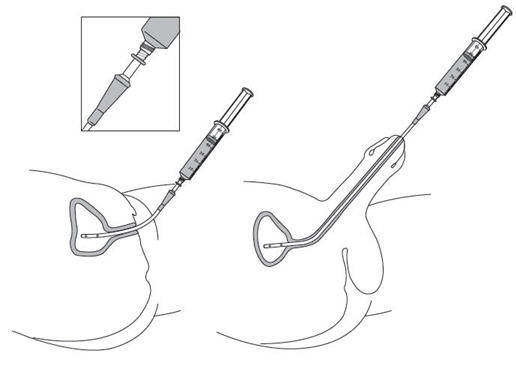These highlights do not include all the information needed to use Cysview safely and effectively. See full prescribing information for Cysview. Cysview (hexaminolevulinate hydrochloride), for Intravesical Solution For bladder instillation only Initial U.S. Approval: 2010
Cysview by
Drug Labeling and Warnings
Cysview by is a Prescription medication manufactured, distributed, or labeled by Photocure Inc, Orifice Medical AB. Drug facts, warnings, and ingredients follow.
Drug Details [pdf]
CYSVIEW- hexaminolevulinate hydrochloride
Photocure Inc
----------
HIGHLIGHTS OF PRESCRIBING INFORMATIONThese highlights do not include all the information needed to use Cysview safely and effectively. See full prescribing information for Cysview.
Cysview (hexaminolevulinate hydrochloride), for Intravesical Solution For bladder instillation only Initial U.S. Approval: 2010 INDICATIONS AND USAGECysview is an optical imaging agent indicated for use in the cystoscopic detection of non-muscle invasive papillary cancer of the bladder among patients suspected or known to have lesion(s) on the basis of a prior cystoscopy. Cysview is used with the Karl Storz D-Light C Photodynamic Diagnostic (PDD) system to perform cystoscopy with the blue light setting (Mode 2) as an adjunct to the white light setting (Mode 1). Important Limitations of Use: DOSAGE AND ADMINISTRATIONTraining in blue light cystoscopy with the Karl Storz D-Light C PDD system is essential prior to the use of Cysview. (2.5)
DOSAGE FORMS AND STRENGTHSCysview (hexaminolevulinate hydrochloride) is supplied as a kit containing:
Once reconstituted, the solution contains 2 mg/mL (8mmol/L) of hexaminolevulinate hydrochloride. CONTRAINDICATIONSDo not use Cysview in patients with:
WARNINGS AND PRECAUTIONS
ADVERSE REACTIONSThe most common adverse reaction reported in patients who received Cysview was bladder spasm, occurring in < 3% of patients, followed by dysuria, hematuria, bladder pain, procedural pain, urinary retention and headache, all occurring in ≤ 2% of patients. (6.1) To report SUSPECTED ADVERSE REACTIONS, contact Photocure Inc. at 1-855-297-8439 or FDA at 1-800-FDA-1088 or www.fda.gov/medwatch. USE IN SPECIFIC POPULATIONSSee 17 for PATIENT COUNSELING INFORMATION. Revised: 11/2011 |
FULL PRESCRIBING INFORMATION
1 INDICATIONS AND USAGE
Cysview is an optical imaging agent indicated for use in the cystoscopic detection of non-muscle invasive papillary cancer of the bladder among patients suspected or known to have lesion(s) on the basis of a prior cystoscopy. Cysview is used with the Karl Storz D-Light C Photodynamic Diagnostic (PDD) system to perform cystoscopy with the blue light setting (Mode 2) as an adjunct to the white light setting (Mode 1).
1.1 Limitations of Use
Cysview is not:
- a replacement for random bladder biopsies or other procedures used in the detection of bladder cancer [see Warnings and Precautions (5.2)].
- for repetitive use. The potential risks associated with repetitive exposure, including sensitization and adverse effects of blue light have not been evaluated [see Warnings and Precautions (5.1)].
2 DOSAGE AND ADMINISTRATION
2.1 Recommended Dose
The recommended dose for adults is 50 mL of reconstituted solution of Cysview [see Dosage and Administration (2.2)], instilled into the bladder via a urinary catheter [see Dosage and Administration (2.3)].
2.2 Reconstitution of Cysview
Cysview is supplied as a kit containing two vials: a clear glass vial labeled as Cysview (hexaminolevulinate hydrochloride) for Intravesical Solution, containing 100 mg hexaminolevulinate hydrochloride as a powder, and a vial labeled as DILUENT for Cysview, containing 50 mL of the diluent in a polypropylene vial.
Perform all steps under aseptic conditions. Use gloves during the reconstitution procedure; skin exposure to hexaminolevulinate hydrochloride may increase the risk for sensitization to the drug.
Use a 50 mL syringe with a Luer Lock tip throughout the reconstitution procedure to ensure that the correct concentration (2mg/mL) of the drug is obtained and that a stable syringe-catheter connection is made for the bladder instillation of Cysview.
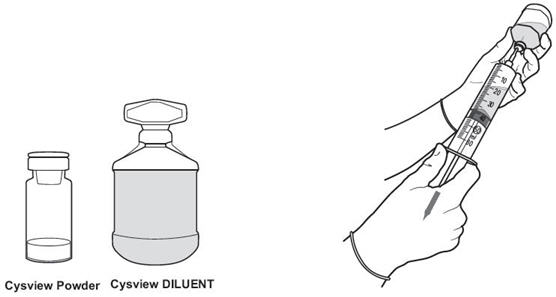
Figure 1.
- 1. Remove the cap from the sterile 50 mL syringe and carefully retain it for subsequent reattachment to the syringe (step 4). Attach a needle to the syringe and withdraw 50 mL of the diluent (Figure 1).
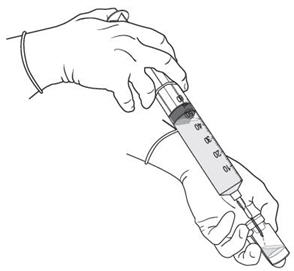
Figure 2.
- 2. Penetrate the stopper of the Cysview powder vial with the needle and inject 10 mL of the diluent from the syringe into the powder vial (Figure 2).
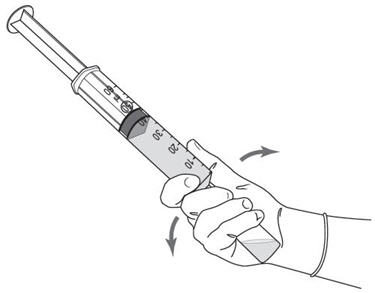
Figure 3.
- 3. Without withdrawing the needle from the vial, hold the powder vial and syringe in a firm grip (Figure 3) and gently shake to dissolve of the powder in the diluent. The powder normally dissolves almost immediately.
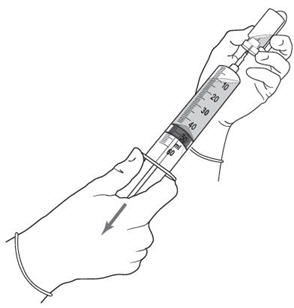
Figure 4.
- 4. Withdraw all of the dissolved solution from the powder vial (10 mL) into the 50 mL syringe (Figure 4).

Figure 5.
- 5. Remove the needle from the powder vial, disconnect the needle from the syringe tip and discard it. Plug the syringe with the syringe cap (Figure 5). Gently mix the contents of the syringe. The reconstituted solution of Cysview is colorless to pale yellow and clear to slightly opalescent, and free from visible particles.

Figure 6.
- 6. Peel off the detachable portion of the label (starting at the corner marked with a black triangle) from the Cysview powder vial and affix it to the syringe containing the solution of Cysview (Figure 6). Add two hours to the present time and write the resulting expiration time and date on the syringe label.
Cysview is now reconstituted and ready for use. Instill the reconstituted solution of Cysview into the bladder. If unable to administer the solution shortly after reconstitution, the solution may be stored for up to 2 hours in a refrigerator at 2°-8°C (36°- 46°F) in the labeled syringe. If not used within 2 hours, discard the solution. [see Dosage and Administration (2.2) and How Supplied/Storage and Handling (16)]
2.3 Bladder Instillation of Cysview
For bladder instillation of the solution of Cysview, use straight, or intermittent, urethral catheters with a proximal funnel opening that will accommodate the Luer Lock adapter. Use only catheters made of vinyl (uncoated or coated with hydrogel), latex (amber or red), and silicone to instill the reconstituted Cysview. Do not use catheters coated or embedded with silver or antibiotics. In-dwelling bladder catheters (Foley catheters) may be used if the catheters are inserted shortly prior to Cysview administration and are removed following the Cysview instillation. Use the following steps for bladder instillation of Cysview:
- 1. Using standard sterile catheterization technique, first insert the urethral catheter into the bladder of the patient and use the catheter to completely empty the patient's bladder before instillation of Cysview.
Figure 7.
- 2. To attach the syringe containing the solution of Cysview to the catheter, do the following:
- Remove the syringe cap from the 50 mL syringe that contains the solution of Cysview.
- Attach the Luer Lock end of the (provided) catheter adapter to the syringe.
- Insert the tapered end of the catheter adapter into the funnel opening of the catheter. See Figure 7, with the connection enlarged in the inset.
- 3. Slowly instill the solution of Cysview into the bladder through the catheter (Figure 7), ensuring that the complete volume of the syringe (50 mL) is administered.
- 4. After the solution is instilled, remove the catheter and instruct the patient to retain the solution within the bladder for at least 1 hour; do not exceed 3 hours [see Dosage and Administration (2.4)]. Patients may stand, sit and move about during the time period between instillation and start of the cystoscopic procedure.
- 5. Evacuate the solution of Cysview from the bladder as part of routine emptying of the bladder immediately prior to the initiation of the cystoscopic procedure (refer to the Karl Storz PDD Telescope Instruction manual). Also, the patient may void and completely empty the bladder prior to the procedure.
Avoid skin contact with Cysview. If skin does come in contact with Cysview, wash immediately with soap and water and dry off. After voiding the bladder of Cysview, routinely wash the patient's perineal skin region with soap and water and dry.
2.4 Use of the Karl Storz D-Light C Photodynamic Diagnostic (PDD) System
Cysview imaging requires the use of the Karl Storz D-Light C PDD system, which consists of a light source, a camera and a telescope. The light source enables both white light cystoscopy and blue light (wavelength 360 – 450 nm) fluorescence cystoscopy. Familiarity with this system is essential before beginning the procedure and before instilling Cysview into the bladder. For system set up and general information for the safe use of the PDD system, refer to the Karl Storz instruction manual for the PDD system and the instruction manuals for each of the system components. The PDD System is not for use by healthcare providers with green-red color blindness.
2.5 Cystoscopic Examination
Training
Training and proficiency in cystoscopic procedures are essential prior to the use of Cysview. Carefully review the instruction manuals provided with the Karl Storz D-Light C Photodynamic Diagnosis (PDD) System. For additional training in the use of the PDD System, contact the manufacturer's representative.
Preparation for Cystoscopy
Initiate the cystoscopic examination within 30 minutes after evacuation of Cysview from the bladder, but no less than 1 or more than 3 hours after Cysview is instilled in the bladder. If the patient did not retain Cysview in the bladder for 1 hour, allow 1 hour to pass from the instillation of Cysview into the bladder to the start of the cystoscopic examination. The efficacy of Cysview has not been established when the solution was retained for less than 1 hour.
Cystoscopic Examination
Empty the patient's bladder and then fill the bladder with a clear fluid (standard bladder irrigation fluid) in order to distend the bladder wall for cystoscopic visibility. Ensure adequate irrigation during examination of the bladder; blood, urine or floating particles in the bladder may interfere with visualization under both white light and blue light.
First perform a complete cystoscopic examination of the entire bladder under white light (Mode 1) and then repeat the examination of the entire bladder surface under blue light (Mode 2) unless the white light cystoscopy reveals extensive mucosal inflammation. Do not perform the blue light cystoscopy if the white light cystoscopy reveals wide-spread mucosal inflammation. Abnormalities of the bladder mucosa during blue light cystoscopy are characterized by the detection of red, homogenous and intense fluorescence. The margins of the abnormal lesions are typically well-demarcated and in contrast to the normal urothelium, which appears blue. Register and document (map) the location and appearance (e.g. papillary) of suspicious lesions and abnormalities seen under either white or blue light.
During the cystoscopic examination, be aware that:
- a red fluorescence is expected at the bladder outlet and the prostatic urethra; this fluorescence occurs in normal tissue and is usually less intense and more diffuse than the bladder mucosal fluorescence associated with malignant lesions.
- tangential light may give false fluorescence. To help avoid false fluorescence, hold the endoscope perpendicular and close to the bladder wall with the bladder distended.
- false positive fluorescence may result from scope trauma from a previous cystoscopic examination and/or bladder inflammation [see Warnings and Precautions (5.3)].
- malignant lesions may not fluoresce following Cysview administration, particularly if the lesions are coated with necrotic tissue. Blue light may fail to detect T2 tumors which have a tendency to be necrotic on the surface, and necrotic cells generally do not fluoresce [see Warnings and Precautions (5.3)].
- when performing the blue light cystocopy, avoid prolonged blue light exposure. Studies have not evaluated the potential for adverse effects from blue light. In the controlled clinical trial, the cumulative blue light exposure from bladder mapping did not exceed 12 minutes and checking for complete tumor resection under blue light did not exceed 8 minutes for any patient [see Clinical Studies (14)].
Perform biopsy and/or resection of suspicious lesions by transurethral resection of the bladder (TURB) only after completing white and blue light cystoscopic examinations with bladder mapping. Using standard cystoscopic practices, obtain biopsies of abnormal areas identified during either white or blue light examination and perform resections. Always check for the completeness of the resections under both white light and blue light before finalizing the TURB procedure.
3 DOSAGE FORMS AND STRENGTHS
Cysview (hexaminolevulinate hydrochloride) is supplied as a kit containing:
- Cysview (hexaminolevulinate hydrochloride) for Intravesical Solution, 100 mg, as a powder in a 10 mL clear glass vial.
- DILUENT for Cysview, 50 mL, in a polypropylene vial.
- One Luer Lock catheter adapter (to connect the syringe containing the reconstituted solution of Cysview to the urethral catheter for bladder instillation of Cysview).
Once reconstituted, the solution of Cysview contains 2 mg/mL of hexaminolevulinate hydrochloride.
4 CONTRAINDICATIONS
Cysview is contraindicated in patients with:
- porphyria
- gross hematuria
- BCG immunotherapy or intravesical chemotherapy within the past 90 days
- known hypersensitivity to hexaminolevulinate or any derivative of aminolevulinic acid
5 WARNINGS AND PRECAUTIONS
5.1 Anaphylaxis
Anaphylaxis, including anaphylactoid shock, has been reported following administration of Cysview [see Adverse Reactions (6.2)]. Prior to and during use of the Cysview, have trained personnel and therapies available for the treatment of anaphylaxis. The safety of repetitive Cysview exposures has not been evaluated.
5.2 Failed Detection
Cysview may fail to detect some bladder tumors, including malignant lesions. Cysview is not a replacement for random biopsies or any other procedure usually performed in the cystoscopic evaluation for cancer. In the controlled clinical trial, Cysview failed to detect 10% of lesions confirmed as malignant within the study drug group [see Clinical Studies (14)]. Do not perform cystoscopy with blue light alone as malignant lesions can be missed unless the bladder is initially examined under white light [see Dosage and Administration (2.5)].
5.3 False Fluorescence
Fluorescent areas detected during blue light cystoscopy may not indicate a bladder mucosal lesion. In the controlled clinical study, biopsies from one of every four fluorescent areas showed neither dysplasia nor carcinoma, if the areas were not also identified during white light cystoscopy [see Clinical Studies (14)]. In addition to these false detections, fluorescent areas within the bladder mucosa may result from inflammation, cystoscopic trauma, scar tissue or bladder mucosal biopsy from a previous cystoscopic examination. The presence of urine and/or blood within the bladder may interfere with the detection of tissue fluorescence. To enhance the diagnostic utility of Cysview with the Karl Storz D-Light C PDD System:
- ensure the bladder is emptied of urine prior to the instillation of fluids at cystoscopy;
- biopsy/resect bladder mucosal lesions only following completion of both white light and blue light cystoscopy;
6 ADVERSE REACTIONS
Anaphylaxis has been reported following exposure to Cysview [see Warnings and Precautions (5.1)].
6.1 Clinical Study Experience
Because clinical trials are conducted under widely varying conditions, adverse reaction rates observed in the clinical trials of a drug cannot be directly compared to rates in the clinical trials of another drug and may not reflect the rates observed in practice.
In six clinical trials, safety data were obtained from 1,324 patients, aged 32 to 96 years with a median age of 69 years, all primarily Caucasian and approximately 75% male. All patients were evaluated after a single instillation of 50 mL solution of Cysview. Of these patients, 161 (12.2%) patients reported at least one adverse reaction. The most common adverse reaction was bladder spasm (reported in 2.2% of the patients) followed by dysuria, hematuria, and bladder pain. No patients experienced anaphylaxis. In the controlled clinical study, adverse reactions were similar in nature and rate between the study drug group and the control group [see Clinical Studies (14)].
6.2 Postmarketing Experience
Because these reactions are reported voluntarily from a population of uncertain size, it is not always possible to reliably estimate their frequency or establish a causal relationship to drug exposure.
Anaphylactoid shock, hypersensitivity reactions, bladder pain, cystitis and abnormal urinalysis have been reported during post-marketing use of Cysview.
8 USE IN SPECIFIC POPULATIONS
10 OVERDOSAGE
No adverse events were reported in a dose-finding study conducted among patients whose bladders were instilled with twice the recommended concentration (dose) of solution of Cysview.
11 DESCRIPTION
Cysview contains hexaminolevulinate hydrochloride, an optical imaging drug that in solution form is instilled intravesically for use with photodynamic blue light cystoscopy as an adjunct to white light cystoscopy. The chemical formula for hexaminolevulinate hydrochloride is C11H21NO3∙HCl. Its molecular weight is 251.76 and it has the following structural formula:

Cysview (hexaminolevulinate hydrochloride) for Intravesical Solution is intended for intravesical administration only after reconstitution with the supplied 50 mL DILUENT. Cysview (hexaminolevulinate hydrochloride) for Intravesical Solution and DILUENT for Cysview are supplied together as a kit. Cysview (hexaminolevulinate hydrochloride) for Intravesical Solution is supplied as a sterile, non-pyrogenic, freeze-dried, white to off-white or pale yellow, powder containing 100 mg of hexaminolevulinate hydrochloride (equivalent of 85 mg of hexaminolevulinate) in a 10 mL clear glass vials. The DILUENT for Cysview is a sterile, non-pyrogenic solution (pH 6) containing 0.61 mg/ mL disodium hydrogen phosphate, 0.58 mg/mL of potassium dihydrogen phosphate, 7.02 mg/mL of sodium chloride, hydrochloric acid, sodium hydroxide, and water for injection. It is a clear, colorless solution, free from visible particles, and is provided in a 50 mL polypropylene vial.
The reconstituted solution of Cysview contains 2 mg/ml of hexaminolevulinate hydrochloride and is colorless to pale yellow. It is free from visible particles and has a pH between 5.7 and 6.2.
12 CLINICAL PHARMACOLOGY
12.1 Mechanism of Action
Cysview is an ester of the heme precursor, aminolevulinic acid. After bladder instillation, Cysview enters the bladder mucosa and is proposed to enter the intracellular space of mucosal cells where it is used as a precursor in the formation of the photoactive intermediate protoporphyrin IX (PpIX) and other photoactive porphyrins (PAPs). PpIX and PAPs are reported to accumulate preferentially in neoplastic cells as compared to normal urothelium, partly due to altered enzymatic activity in the neoplastic cells. After excitation with light at wavelengths between 360 and 450 nm, PpIX and other PAPs return to a lower energy level by fluorescing, which can be detected and used for cystoscopic detection of lesions. The fluorescence from tumor tissue appears bright red and demarcated, whereas the background normal tissue appears dark blue. Similar processes may occur in inflamed cells.
12.2 Pharmacodynamics
In vitro studies have shown increased porphyrin fluorescence in normal urothelium after exposure to Cysview. In the human bladder, a greater accumulation of porphyrins is proposed in neoplastic or inflamed cells, compared to normal urothelium. After bladder instillation of Cysview for approximately 1 hour and subsequent illumination with blue light at wavelengths 360 – 450nm, the porphyrins will fluoresce red [see Dosage and Administration (2.5)].
12.3 Pharmacokinetics
After bladder instillation of [14C]-labeled Cysview (100 mg) for approximately 1 hour in healthy volunteers, absolute bioavailability of Cysview was 7% (90% confidence interval [CI]: 5%-10%). The [14C]-labeled substance(s) showed biphasic elimination, with an initial elimination half-life of 39 minutes, followed by a terminal half-life of approximately 76 hours. Whole blood analysis showed no evidence of significant binding of Cysview to erythrocytes. An in vitro study showed that Cysview underwent rapid metabolism in human blood.
13 NONCLINICAL TOXICOLOGY
13.1 Carcinogenesis, Mutagenesis, Impairment of Fertility
No studies in animals have been conducted to evaluate the carcinogenic potential of hexaminolevulinate hydrochloride.
Hexaminolevulinate hydrochloride was not mutagenic in in vitro reverse mutation tests in bacteria, or in chromosome aberration tests in human peripheral blood lymphocytes, and was negative in an in vivo micronucleus test in mice after intravenous injection of doses up to 45 mg/kg in the absence of light activation. Adequate studies have not been performed to evaluate the genetic toxicity of hexaminolevulinate hydrochloride in the presence of light activation.
Adequate reproductive and developmental toxicity studies in animals have not been performed to evaluate the effects of hexaminolevulinate hydrochloride on fertility.
13.2 Animal Toxicology and/or Pharmacology
Dose dependent neurological effects such as tremor, increased motor activity, and increased startle and touch escape responses were observed immediately after dosing at doses ≥ 30 mg/kg (24 times human systemic exposure based on the body surface area, using 10% as the upper level of 90% confidence interval of bioavailability) in a single dose rat study. The animals recovered to normal status by 60 min after dosing. Adverse neurological effects were also noted in other single or repeat dose toxicity studies.
Hexaminolevulinate hydrochloride had moderate to strong potential to cause skin sensitization based on a local lymph node assay in mouse.
14 CLINICAL STUDIES
The safety and efficacy of Cysview when used with photodynamic cystoscopy were studied in a prospective, multicenter, controlled clinical trial. Adult patients with known or suspected bladder cancer were randomized to either white light (WL) cystoscopy (control group, n = 384) or WL followed by blue light (BL) cystoscopy (study drug group, n = 395). Only the study drug group patients received Cysview by bladder instillation prior to cystoscopy. After bladder evacuation of Cysview, bladder lesion mapping was performed initially using the Karl Storz PDD system in the WL mode followed by lesion mapping in the BL mode. Control group patients underwent only WL cystoscopy with lesion mapping. The average age of the randomized patients was 69 years (range 24 to 96); 78% were male and 94% were Caucasian. All patients had previously undergone cystoscopy.
The main diagnostic efficacy outcome was assessed within the study drug group. This assessment compared lesions detected during an initial cystoscopic examination to their centralized histologic findings (the standard of truth). Following the initial diagnostic cystoscopy, patients within both study groups who had histologically confirmed Ta and/or T1 lesions underwent follow-up WL cystoscopy at 3, 6 and 9 months; these histologic evaluations were based upon the site assessments at both the initial and follow-up cystoscopy.
Diagnostic efficacy assessed the number of patients within the study drug group who had at least one additional Ta or T1 bladder cancer detected only by BL; the proportion of these patients was compared to a proposed threshold proportion of 10%. Within the study drug group, 286 patients had at least one Ta and/or T1 lesion, including 47 patients who had at least one of the lesions detected only by BL (see Table 1).
|
|
|
| Number of patients with any Ta and/or T1 lesion detected with either WL or BL | 286 |
| Number (%) of patients with any Ta and/or T1 lesion detected only with BL | 47 (16%) |
| p-value* | 0.001 |
Some malignant lesions were detected only by WL or BL (see Table 2).
| Number of lesions | Detected by Both WL & BL | Detected by WL Only | Detected by BL Only |
|---|---|---|---|
| CIS, n = 66 | 33 | 6 | 27 |
| Ta, n = 580 | 472 | 52 | 56 |
| T1, n = 95 | 76 | 10 | 9 |
| T2 – T4, n = 47 | 38 | 8 | 1 |
Among the lesions detected only by BL, 23% were negative for any carcinoma-related pathology, including dysplasia. Among the lesions detected only by WL, 17% were negative for any carcinoma-related pathology, including dysplasia.
16 HOW SUPPLIED/STORAGE AND HANDLING
Cysview is supplied as a kit labeled, Cysview (hexaminolevulinate hydrochloride) Kit for Intravesical Solution, 100 mg. The kit contains:
- One vial of Cysview (hexaminolevulinate hydrochloride) for Intravesical Solution, 100 mg, as a powder in a 10 mL clear glass vial.
- One vial of DILUENT for Cysview, 50 mL, in a polypropylene vial.
- One Luer Lock catheter adapter (to connect the syringe containing Cysview solution to the urethral catheter during instillation of Cysview).
NDC: 10511-3001-1
Storage
Store Cysview (hexaminolevulinate hydrochloride) Kit for Intravesical Solution at 20°-25°C (68°-77°F); excursions are permitted to 15°-30°C (59°-86°F). Do not use beyond the expiry date printed on the carton. Use the solution of Cysview shortly after reconstitution. If unable to use within this time period, the reconstituted solution can be stored under refrigeration at 2°-8°C (36°-46°F) for up to 2 hours in the 50 mL labeled syringe.
17 PATIENT COUNSELING INFORMATION
Ask patients if they have:
- a diagnosis or a family history of porphyria
- allergy to aminolevulinic acid or prior exposure to Cysview
- gross hematuria
- had BCG immunotherapy or chemotherapy within the bladder.
Inform patients that Cysview should be retained in the bladder for 1 hour from instillation of Cysview to the start of the cystoscopic procedure. If the patient cannot hold Cysview for 1 hour, but needs to void and expel Cysview from the bladder, he or she may void and should then inform a health care professional [see Dosage and Administration (2)].
Distributed by Photocure Inc. Princeton, NJ 08540 U.S.A.
Packaged and Labeled by Orifice Medical AB Ystad, Sweden
Cysview is a trademark of Photocure ASA.
Photodynamic Diagnostic (PDD) system is a trademark of Karl Storz Endoscopy-America, Inc.
Photocure and the Photocure logo are trademarks of Photocure ASA.
© 2011 Photocure ASA – All rights reserved.
CYSC2012008
PRINCIPAL DISPLAY PANEL - KIT CARTON
PHOTOCURE®
Rx ONLY
Sterile.
Single Use Containers.
Discard unused portion.
ONE KIT
NDC 10511-3001-1
Cysview®
(hexaminolevulinate HCl)
KIT for Intravesical Solution
100 mg
For Bladder Instillation Only after
Reconstitution
Each KIT contains:
-
1 vial Cysview®(hexaminolevulinate HCl) for
Intravesical Solution 100 mg - 1 vial DILUENT for Cysview®
- 1 Luer Lock catheter adapter
Reconstitution with supplied DILUENT for Cysview®
required before use (see insert).
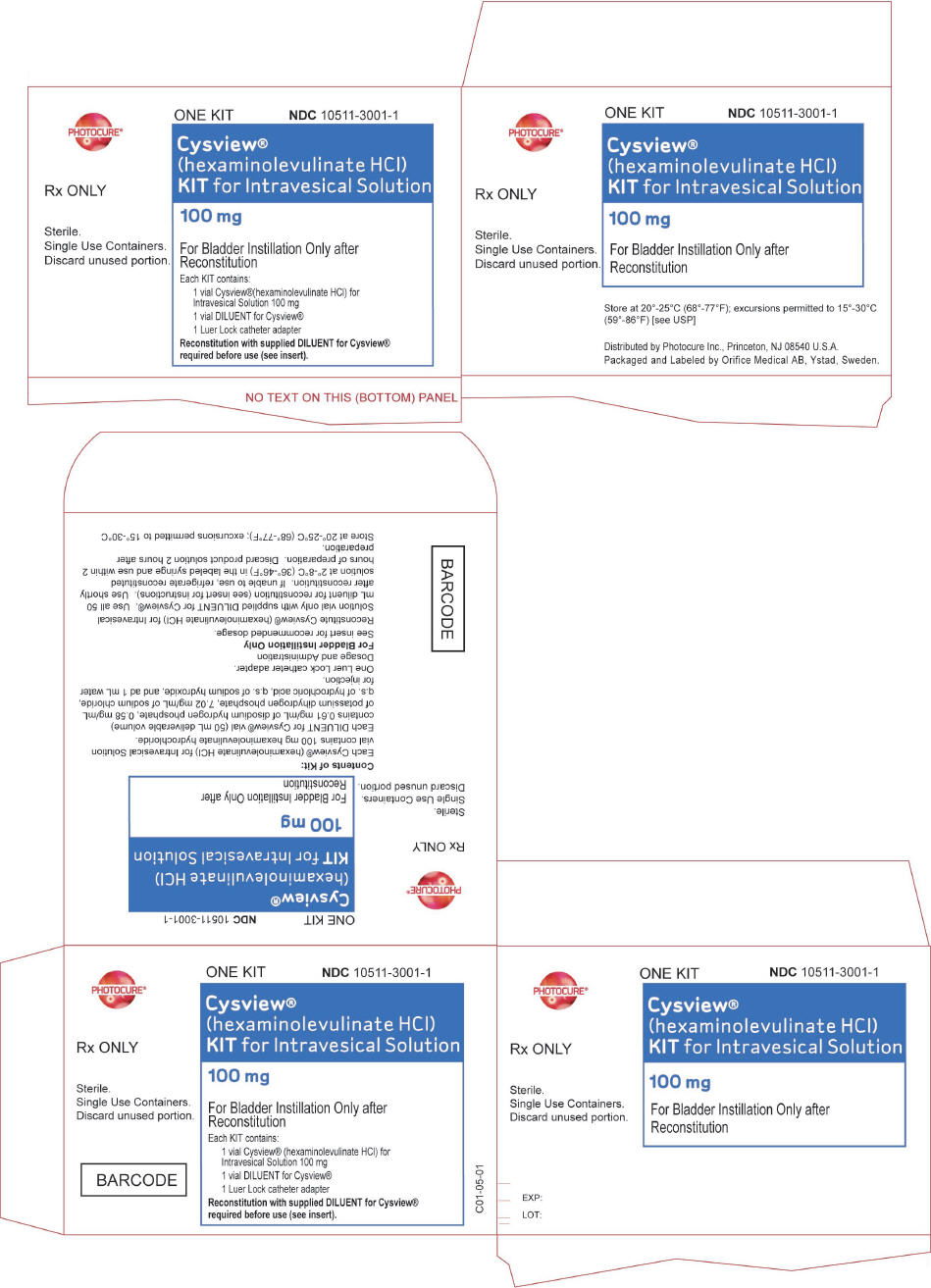
| CYSVIEW
hexaminolevulinate hydrochloride kit |
||||||||||||||||
|
||||||||||||||||
|
||||||||||||||||
|
||||||||||||||||
|
||||||||||||||||
|
||||||||||||||||
|
||||||||||||||||
|
||||||||||||||||
|
||||||||||||||||
|
||||||||||||||||
|
||||||||||||||||
|
||||||||||||||||
|
||||||||||||||||
|
||||||||||||||||
|
||||||||||||||||
| Labeler - Photocure Inc (006629060) |
| Establishment | |||
| Name | Address | ID/FEI | Business Operations |
|---|---|---|---|
| Orifice Medical AB | 508917689 | LABEL(10511-3001) , PACK(10511-3001) | |
